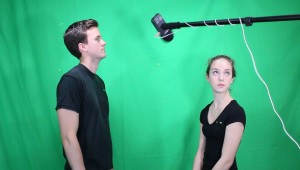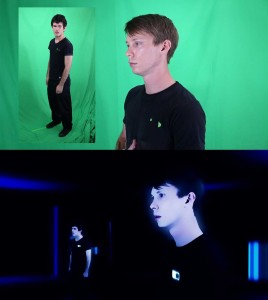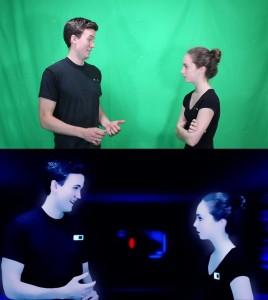
Very often, cinema craftspeople from all corners of the industry engage in making their own feature film, often as director, producer, or in some other key capacity. But very few of them undertake nearly every crucial role on their first film, including writer, director, producer, cinematographer, editor, production designer, and co-composer. Enter John Aaron Goold.
Of course, Goold was new to the many departments which he ultimately supervised on the sci-fi picture Immersion, now available online as a download and streaming video. “I’d been dabbling with moviemaking since I was a teenager,” said Goold. “At 24-25, I realized I could make my own movie with no money. I watched commentary for Christopher Nolan’s movie Following and was blown away because he made the movie for $6,000.”
Inspired by Nolan, Goold, who began with a goal to shoot his first project on 16mm film, conspired in May, 2011 to shoot a full feature in an interior apartment with natural light streaming in through nearby windows. Some adjustments followed, leading to further study of micro-budget features. “Clerks and Primer were made with no money,” Goold noted. “Why can’t I do that? Nolan said that the biggest jump for him was from Following to Memento; going from no money to $1,000,000 was a bigger jump than $1 million to $100 million.”
In planning his extremely low-budget outing, Goold brainstormed many ideas which never made it into script form. “I moved from New York to L.A. and got focused on moving,” he stated of his transitory period, common to new filmmakers. “Once I moved, I was living with my cousin, sitting in this empty room and thinking, ‘I should shoot something here. Do an entire movie greenscreen in a 10×10 apartment.’”
 To kick-start the project, Goold worked in Photoshop and devised a look for a virtual environment which piqued his creative juices. “I could do a sci-fi-Tron-esque movie,” he thought, referencing other filmmakers who had extracted considerable production value from very few material resources. “They all make funny little shorts or graphics, commercials or promos. Nobody is making a full-on feature – nobody had really done it.”
To kick-start the project, Goold worked in Photoshop and devised a look for a virtual environment which piqued his creative juices. “I could do a sci-fi-Tron-esque movie,” he thought, referencing other filmmakers who had extracted considerable production value from very few material resources. “They all make funny little shorts or graphics, commercials or promos. Nobody is making a full-on feature – nobody had really done it.”
With his greenscreen vision and virtual scenario goals, Goold moved into the story phase of his budding project. “How do I make the world as interesting as possible?” he wondered. “I immediately started focusing on what kind of characters and themes I wanted to do. Shooting a movie for $7,000 in your apartment is a gimmick if that’s the only thing you have. Do you have an interesting story with interesting characters? Do the aesthetics achieve what you want to do with the story? What kind of story would fit this very low key production?”
Early drafts of his script differed from the eventual shooting script. Then, Goold hired actors and made a one-minute early trailer to generate additional ideas. “I produce things as I write,” he revealed of his methodology in creating screen roles. “The main character, Travis, made a 50% change in the process. Rhea and his brother and the rest of those characters were very new and came much later. It was going to be him and his friend having these strange experiences. I found the Rhea character more interesting. She became the second-most important character.”
With a mantra of “What can do with the things I already have?” Goold moved into a sparse version of pre-production, though he resists the catchall title of ‘zero-budget filmmaking.’ “There’s really no such thing as a zero-budget,” he remarked. “It’s about time and energy and asking for favors. Your family will let you borrow their place for a weekend. More than just money, it’s people’s commitment to something. I try to think of, ‘What do I have that I can already do that will be there throughout me making this?’ I knew that I could do a certain amount of things with computers. All I needed was some reliable actors. I wanted to pay my actors, but how much could I afford to pay them? Robert Rodriguez said, ‘Look at what you have.’”
After laboring for 9-10 months on Immersion’s screenplay, at the time of pre-production, Goold was working full-time for Lionsgate as a ‘grunt’ and made the transition to video editing on America’s Funniest Home Videos where he earned ‘pretty good money’ which would factor into his budget. “I had some money saved up,” he related. “I spent $3,000 on the whole thing including paying actors and buying stuff from Home Depot. I borrowed things from a non-profit.”
 Heading into production, Goold noted that he had very minimal help on set. “My roommate ran sound once in a while,” he commented, an amusing aside to a nearly entirely self-made project. “Psychologically, I was nervous, but I prepared somewhat well. I’m not big on improv or shaky cam. Every move had to be planned out. I have the mock trailer and storyboards that I did. I prepared the hell out of it. Every single moment, I had storyboarded. I edited the entire movie as a storyboard and read the scenes myself and put music to it. That’s how all animated movies are made. A very crude, drawn version. It helped my actors because all they had were greenscreens. When they know what’s going on, it’s not just me coaching them. You shoot the whole thing as best you can, but you have the whole movie pretty much done before any major work. The shooting was a gradual process for me.”
Heading into production, Goold noted that he had very minimal help on set. “My roommate ran sound once in a while,” he commented, an amusing aside to a nearly entirely self-made project. “Psychologically, I was nervous, but I prepared somewhat well. I’m not big on improv or shaky cam. Every move had to be planned out. I have the mock trailer and storyboards that I did. I prepared the hell out of it. Every single moment, I had storyboarded. I edited the entire movie as a storyboard and read the scenes myself and put music to it. That’s how all animated movies are made. A very crude, drawn version. It helped my actors because all they had were greenscreens. When they know what’s going on, it’s not just me coaching them. You shoot the whole thing as best you can, but you have the whole movie pretty much done before any major work. The shooting was a gradual process for me.”
On set, Goold’s actors, working solely with greenscreens in a virtual environment, “did not understand much of what was going on” according to the filmmaker. After a round of auditions, he communicated that “the people who made it sound good were called in for follow-ups. As long as they understood their relationship to the character, that was the most important part… actors have to try twice as hard dealing with sci-fi or greenscreens.”
Given his rigid pre-production approach, Goold stuck to his plan throughout the process. “Nothing changed – everything in the storyboards is in the movie,” he said. “The only thing that’s different is the ending. I had another ending, but there were too many things bugging me about it. What if I throw it out entirely? Scott Baxter, my actor, came up with the format of the ending. That was the biggest change – how the ending was shot.”
Production unfolded slowly from September 2012 to January 2013. “It was sometimes one day a week,” Goold stated, adding that when he was 75% finished with shooting, he went back to working full-time. “September, I shot 4-5 days for three weeks. All the San Clemente exterior stuff was shot in mid-September. We shot mainly in September and October. 25% was shot through the rest of the months.”
As with many independent filmmakers, for Goold, the Canon series of DSLR cameras which shoot 24-frame video provided useful and inexpensive on Immersion. Goold utilized the “Rebel” series of cameras with an 18mm to 35mm zoom lens for all of his shots except a 50mm prime lens incorporated for closeups. His media recorded onto 32GB SD cards.
Since he was responsible for both production and post, Goold began to edit Immersion while he was shooting. “I wanted immediate feedback on my progress,” he said. “I wanted to test my effects. I would shoot the thing and get a rough cut – get rid of the greenscreen and throw in some temporary backgrounds. I did reshoot some stuff because I didn’t like the writing and flow. Some stuff, I reshot but didn’t use in the final movie. Everything else was a one-time deal.”
As Goold was the only artist working on the film in post, he described the process as being “very slow and not very wise. You can hire out people to do more tedious tasks like motion-tracking and rendering and outsource those things. That was the only reason it went so slow. Building the actual effects was simple. I used Premiere 5 and 5.5 and After Effects and Photoshop on a Hackintosh. I wanted the SSD drive to handle the effects. I had a bank of hard drives. I have Code 42, a backup service that links to my computer and uploads my hard drives.”
During post, more so than the technical challenges, Goold explained that he had aesthetic choices which became equally if not more difficult to overcome. “The movie was coming together, but the problem was my standards and expectations were changing,” he said of postproduction which took roughly 18 months. “The hardest part was to convince myself to keep going. It was hard to look at those things and make a stiff upper lip and keep going. You accept it for what it is; I learned how to have that attitude. I went into it thinking it would be a portfolio piece. As you’re doing it, you want more out of it – something that could light the world on fire. You can’t set your standards lower – you have to have that momentum – something that is going to be the greatest thing ever. If you don’t go in there wishing for all the world, you aren’t going to have the energy to go in there.”
Editing in the same apartment where he shot the movie, 85% of postproduction work was done within 2013. “I was tweaking things all the way up until July, 2014,” Goold said. “Most of it was done within a 10-month period. 10% was done over the rest of the next six months.”
Having first conceived of the one-room feature film idea in May of 2011, Goold finally finished his film in July of 2014. “Three years from thinking of it to finally making no more changes,” he stated. “Now, I’m still in the process of finding out how to distribute it and market it. I talked to a bunch of friends who made movies and distributed them. The beauty of making a zero-budget film is that you can afford to make mistakes.”
After cutting was complete, Goold used Adobe Media Encoder H.264 to export various sizes. “I had a Pro Res version for when I would screen it in theaters – at one film festival in Dubuque, Iowa,” he said. “I screened it at Lions gate for friends and family. The quality of the projection and sound were so great. In a way, the movie had a very different impact in a dark theater which feels like an extension of the universe that you’re in.”
Though his film has been discovered by a gradually increasing audience, including availability on VHX and Amazon, Goold seemed content that the film successfully serves as a tool to realize another project. “There’s something bigger in the works,” he confessed. “Immersion teases something larger. I should have done more audience market research about what I wanted to do. I would have had a better script and wouldn’t have been working so hard now to find the audience.”
The young filmmaker is already setting more lofty goals for his next project. “I definitely want to step up the game,” he said. “I want to get excited about something that will appeal to a lot of people. The best work for me is the work that inspires other people to do things.”





